Driving Through The Australian Outback
How to not get stuck, not get lost, not get bogged...
Many travellers ask me for tips and advice for driving through the Australian Outback.
Most want to cross Outback Australia on one of the major highways: the Stuart Highway through the Red Centre, the Eyre Highway across the Nullarbor...
Everything you need to know about these kind of drives is covered on the previous page about travel in the Australian Outback.
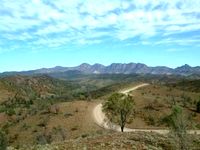
But not all the Australian Outback roads are sealed. In fact, most of the roads out here are unsealed, and many require a four wheel drive vehicle.
Some travellers are more adventurous than others, and some have more time to explore. Many would like to get off the beaten track, and we all enjoy getting away form the other tourists, don't we?
This page contains advice for driving on unsealed roads, because if you plan on driving through the Australian Outback you will at some stage want to drive on unsealed roads...
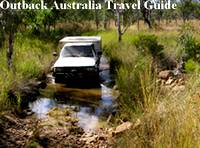
- General Tips And Preparation
- Speed
- Wildlife
- Cattle Stations
- Wet Weather and Flooding
- Bogged - What Now?
Driving In The Australian Outback
Hazards, Tips and More
Preparation
Many of the unsealed Australian Outback roads are well maintained gravel roads. This is particularly true for roads to major tourist attractions. Mostly 4x4 is not necessary.
But these roads are vulnerable. A lot of traffic can lead to bad corrugations, the rattling is hard on your bones and hard on your car. (Corrugations are ridges and dints that make the road look like a sheet of corrugated iron...)
Rain can cause wash outs, creeks can flood the road, and bog holes can remain long after.
Of course, if you are told that 4x4 is indeed required, then don't go in your sedan towing a caravan...
But what if the road is not a popular, well travelled route to a big tourist attraction?
If you want to leave the bitumen and drive in the real Australian Outback make sure you find out about the present state of the roads first!
Enquire at the next tourist centre, or simply ask the locals. Ask the police, the rangers, the petrol station, or even at the pub. If you have access to the internet check the links on this page for Australian Outback road reports and more Outback information. And read on about the hazards and difficulties you might encounter on such a drive.
To start with make sure you have proper directions and a very detailed and current map of the area.
If you have no experience with 4x4 and are renting a car, make sure you know how to engage the four wheel drive.
I'm sure you want to avoid a scenario like that of the couple from the Netherlands who got bogged in Litchfield National Park (not exactly a deserted part of Australia). They activated an emergency beacon (for life threatening situations only) which of course caused a huge rescue operation. The rescuers arrived, engaged the four wheel drive and drove the car out of the bog... So, please!
(Read a similar story sent in by a reader: this first time 4x4 driver was brave enough to share his story publicly.)If at all possible, don't go it alone. The best way to avoid trouble is to find some other vehicle to accompany you on your drive through the Australian Outback.
One more easy way to be safe: Let someone know what you are up to! Tell someone where you are driving and when you intend to be back/arrive at your destination. When you do arrive don't forget to check back in.
Speed
Driving in the Australian Outback gives distances a different meaning. When planning a big trip it's best to assume an average travel speed of no more than 50kms/hr on unsealed roads. On a good stretch of road you will most likely go faster, but 50kms/hr takes the rough spots into account. (On a bad road it will be a lot less than that.)
If you are not used to driving on unsealed Outback roads and tracks go slow! It is true that corrugations aren't felt as badly if you go fast enough. But keep in mind how little contact your wheels have with the road if you just fly over the top of these corrugations. You will have precious little control over your car, and you might just need it...
Think about your shock absorbers, too. Spares are hard to come by in the middle of nowhere...
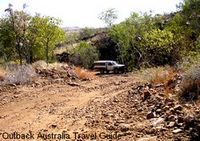
Another hazard that is made worse by speed is the danger coming from sharp edged rocks on the road.
The faster you drive, the bigger your chance to have one of your tyres slit open...
Wildlife
On the previous page about driving in the Austrailian Outback I wrote about cattle and other animals on the road. To consider wildlife is even more important once you leave the highways. Wildlife is plentiful in the Outback. (Information about what to expect is available - you guessed it - from the locals.)
Dusk and dawn are the most dangerous times for driving, it's best just to have a break instead.
If you see kangaroos, wallabies, emus... anything, slow down! Even if they don't seem to be heading your direction, they have a terrible habit of turning around in the last second to dive straight under your wheels. And if you see one or two there is likely to be a third and more...
I guess I should mention the locusts (a kind of grasshopper). Here in the north we get big swarms of them at the beginning of the dry season. They clog up your radiator in no time and several tourists cook the engines of their cars this way every year... Keep a close eye on the engine temperature and stop every now and then to scrape the locust glue off.
Cattle stations
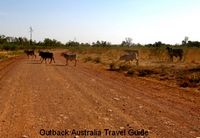
The fact that many public roads lead through cattle stations (ranches) also means that once you turn off that main road/track you are on private land and are actually trespassing.
So find out beforehand if you are allowed to drive to a certain waterfall located on a sidetrack.
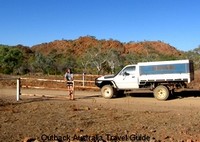
All it usually takes is a phone call to the station owner/manager to get permission. They like to know who is on their land, just like you'd like to know who is poking around your backyard.
One more thing about driving on Outback cattle stations: you will come across many gates. They are there for a reason! If they are open, leave them open. If you find them closed make sure you close them again!
Wet weather
During the wet season in northern Australia (November - April) you will encounter other difficulties. Many Australian Outback roads are impassable during that time of the year, and will be closed. If you ignore the closed sign you risk a fine of $5000 and you may lose your licence.
An open road is no guarantee! The weather can change suddenly.
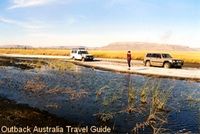
A downpour many kilometres away can make a creek swell enough to stop you from driving across.
Flats can be treacherous. They look dry on top, but underneath... bottomless mud. Take care, and if in doubt get out and walk across to check.
If a road is open for four wheel drive only (as opposed to the ubiquitous "four wheel drive recommended") then there is a good reason for it. Either deep water on the road, or rocks and boulders that require high clearance, wash outs that a normal car can't climb through, steep banks... You will need a four wheel drive vehicle.
Bogged
This site offers advice for driving in the Australian Outback for the average traveller, not the extreme 4x4 enthusiast. I will not go into details and the how to of recovery methods, but I will give you some general tips.
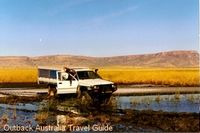
First of all, it happens to the best of us: we get bogged. So don't panic.
Get out, have a drink, look at the situation and your options. Whatever you do, stay with your vehicle, unless you know for sure that help is nearby, and you know for sure how to get there.
Often it's not as bad as it looks. Here are a few tips that might get you out of trouble.
This is a list of things I always have on board when going on longer Australian Outback drives:
- Plenty of water and plenty of fuel (you may use a lot more than on the highway...).
- A good high lift jack and something to use as a base plate for it.
- A long handled shovel.
- My trusty little compressor.
- Two spare tyres.
- A tow rope and a snatching strap, a couple of shackles.
- Some tools.
- My car is also equipped with a winch, so far I haven't needed it.
- If I'd ever go somewhere really, really deserted I'd have a satellite phone.
Don't spin the wheels and get yourself deeper into it!
If you're in deep sand, deflate your tyres. Yes, it works. Believe me. My car is useless in sand (little power, little clearance) and I have to do it all the time. Try 25 psi to start with, go lower if you need to, provided you carry a small compressor. You have to reinflate the tyres when you get back on firm ground. A small compressor for emergencies is very cheap, and I would not be without it.
Sand or mud: Use a shovel to dig away sand or mud in front or behind the wheels (and under the diff if necessary). Collect material to put in the wheel ruts to provide some grip. Stones, timber branches, grass... Use the jack on a plate (or it will just sink) to lift the car and put some materials under the wheels.
You might have to do this several times until you are back on firm ground. And don't despair if it doesn't work straight away. Keep trying.
If you have a winch, use it. No trees in sight to winch from? An old trick that works without fail is to bury your spare tyre and anchor the winch line to it before you fill the hole in. It works, but it is a lot of work. The hole needs to be at least 1.5 metres deep! (And if you do use a tree as anchor point protect the trunk with a blanket or similar!)
While working make sure you drink enough, wear a hat and have breaks. Consider waiting for the cooler time of the day. You're not helping anyone if you get heat struck on top of getting bogged!
You might just be lucky enough for someone else to come along in the meantime...
Find more articles about the Australian Outback
Return from Driving In The Australian Outback to Outback Australia Travel Guide home page





